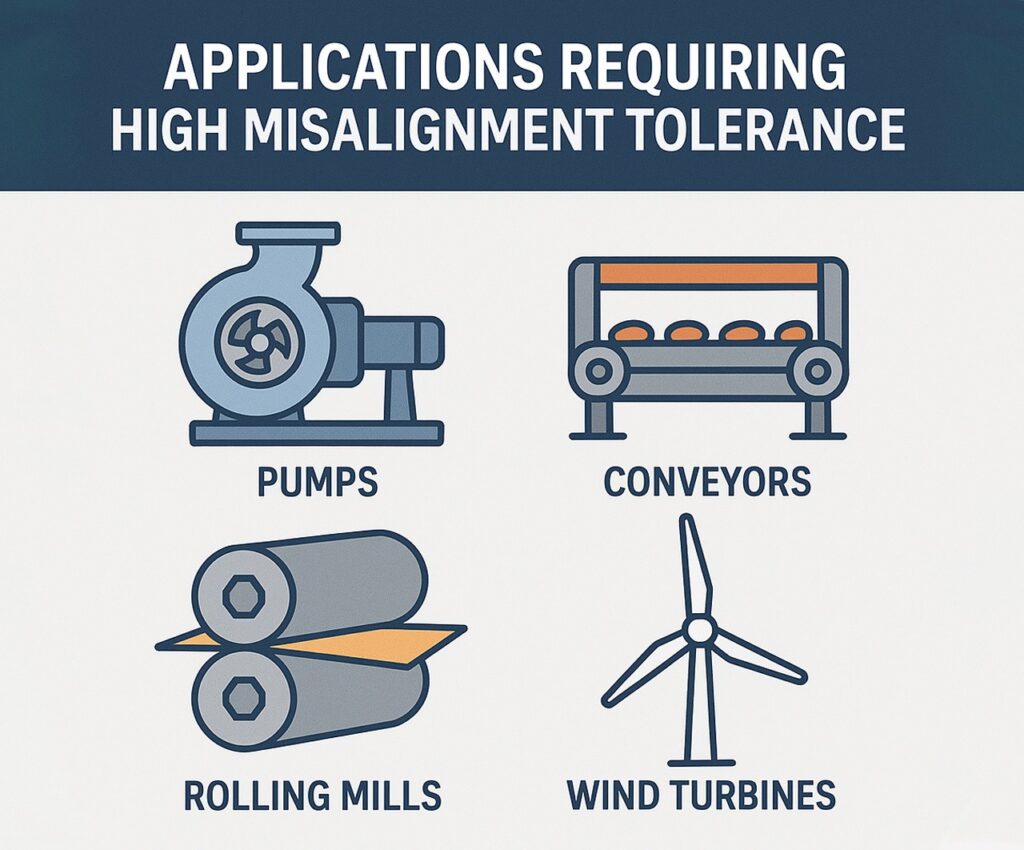In many industrial and mechanical systems, perfect alignment between rotating shafts and bearing housings is a luxury—not a guarantee. That’s why components like the mounted spherical bearing, radial spherical bearing, and sealed spherical bearing have become essential in applications that demand high misalignment tolerance. These specialized bearings allow for angular displacement between the shaft and housing, reducing stress, enhancing load distribution, and extending equipment life. This article explores where these bearings are most needed and why their ability to handle misalignment makes them indispensable. Know More
What Is Misalignment and Why Does It Matter?
Misalignment occurs when the centerline of a shaft does not align perfectly with the bearing’s centerline. It can result from:
- Improper installation
- Thermal expansion
- Shaft deflection
- Load-induced deformation
- Vibration or shifting under operation
When left unchecked, misalignment leads to increased friction, accelerated wear, and premature bearing failure. Bearings designed to accommodate this dynamic—such as the radial spherical bearing—provide an engineered solution for environments where alignment can’t be guaranteed.
Bearing Designs That Support Misalignment
1. Mounted Spherical Bearing
A mounted spherical bearing is housed in a rigid structure like a pillow block or flange unit, but the bearing itself allows for shaft misalignment through a spherical inner race. These are widely used in:
- Conveyors
- Material handling systems
- Agricultural equipment
Their housing provides stability while their spherical design allows for a wide range of motion.
2. Radial Spherical Bearing
The radial spherical bearing consists of an inner ring with a spherical convex outside surface and an outer ring with a matching concave inner surface. This design allows for angular rotation around a central point—ideal for applications with high radial loads and fluctuating shaft angles.
These bearings are commonly found in:
- Hydraulic cylinders
- Suspension systems
- Articulating joints in construction machinery
3. Sealed Spherical Bearing
A sealed spherical bearing takes the core design of the spherical bearing and adds integrated seals to protect against dirt, moisture, and contaminants. These are best suited for outdoor, high-dust, or washdown environments where durability and minimal maintenance are priorities.
Applications include:
- Forestry and mining equipment
- Food processing machinery
- Marine hardware
Industries That Depend on High Misalignment Tolerance
1. Agriculture
Tractors, combines, and tillage equipment operate on uneven terrain and carry heavy loads, causing frequent shaft deflections and structural shifts. The mounted spherical bearing is perfect here, enabling flexibility and reducing stress on shafts.
2. Construction and Earthmoving
Bulldozers, excavators, and dump trucks experience high-impact loading and constant movement. Components like radial spherical bearing types are used in pivot joints and arm linkages, where alignment is never constant.
3. Renewable Energy (Wind Turbines)
Wind turbine blades are exposed to fluctuating wind loads and constantly shifting orientations. Bearings in these systems must accommodate varying angles while supporting significant axial and radial loads.
4. Mining
Harsh environments with dust, debris, and vibration call for rugged components. A sealed spherical bearing ensures longevity while managing alignment inconsistencies in crushers and conveyor systems.
5. Food and Beverage
In systems exposed to water and cleaning chemicals, corrosion-resistant sealed spherical bearing units provide protection while allowing for misalignment in high-speed bottling or packaging lines.
Benefits of Using Spherical Bearings in Misaligned Systems
- Reduced Mechanical Stress By absorbing angular misalignment, these bearings prevent stress concentrations that can crack housings or warp shafts.
- Longer Equipment Life Components last longer when forces are properly distributed. A radial spherical bearing minimizes edge loading and premature failure.
- Fewer Maintenance Interruptions The use of sealed spherical bearing units reduces the need for constant lubrication and cleaning in dirty or corrosive settings.
- Enhanced System Flexibility Systems with moving parts or shifting loads—like mounted spherical bearing configurations—benefit from bearings that move with the load, not against it.
- Better Vibration Absorption Vibration from motors, terrain, or high-speed motion is absorbed more effectively when misalignment is permitted.
Key Considerations for Selection
Choosing the right spherical bearing for high misalignment tolerance depends on a few factors:
- Load Type: Radial, axial, or combined. Radial spherical bearing types excel in radial-heavy environments.
- Operating Environment: For wet, dusty, or corrosive setups, a sealed spherical bearing is critical.
- Misalignment Range: Bearings come with different angular movement capabilities—some up to ±15°.
- Installation Constraints: Mounted spherical bearing units offer ease of installation with pre-fitted housings.
- Maintenance Access: Sealed units reduce ongoing maintenance needs, ideal for remote or hard-to-reach machinery.
Common Design Configurations
- Pillow Block Units: These come pre-mounted with a mounted spherical bearing, simplifying alignment and replacement.
- Flange Units: Ideal for wall-mounted systems needing angular flexibility.
- Rod Ends: Feature a spherical bearing integrated into a threaded shaft for easy adjustment in linkages and arms.
- Weldable Housings: Offer customizable mounting for specialized equipment.
Innovations in Spherical Bearing Technology
- Self-Lubricating Materials New bearings use PTFE liners or composite cages to reduce or eliminate the need for lubrication.
- Integrated Sensors Smart bearings now include temperature and vibration sensors for real-time monitoring in critical systems.
- Corrosion-Resistant Alloys For marine and chemical applications, bearings made from stainless steel or nickel alloys extend life.
- Compact Sealing Systems Seals on sealed spherical bearing designs are becoming more compact without sacrificing protection—improving performance in tight spaces.
Troubleshooting Misalignment Issues
Even with high-tolerance bearings, certain issues can arise:
- Premature Wear: Could indicate overload or misapplication of bearing type.
- Noise and Vibration: May suggest inadequate sealing or lubrication.
- Cracking or Housing Damage: Sign of extreme misalignment or improper installation.
Solutions:
- Reevaluate shaft and housing alignment.
- Upgrade to higher-grade mounted spherical bearing units.
- Ensure proper load calculations and bearing sizing.
Real-World Case Studies
Case 1: Conveyor System in a Gravel Plant Switching from standard ball bearings to sealed spherical bearing units cut bearing failure by 70% and extended lubrication intervals by 6 months.
Case 2: Agricultural Pivot Irrigation Mounted spherical bearing systems allowed for flexible movement across uneven terrain, reducing stress fractures on arms and joints.
Case 3: Offshore Oil Platform Cranes Using radial spherical bearing units with advanced coatings improved operational life by 3x in a saltwater environment.
Final Thoughts
Misalignment is inevitable in many real-world mechanical systems. Whether you’re building heavy-duty construction machinery, operating in corrosive environments, or streamlining packaging lines, components like the mounted spherical bearing, radial spherical bearing, and sealed spherical bearing ensure flexibility, reduce downtime, and extend operational life.
These aren’t just bearing choices—they’re strategic design decisions for maximizing performance in the most misaligned, dynamic, and demanding environments. Choosing the right bearing for high misalignment tolerance is not just about fit—it’s about future-proofing your machinery.

